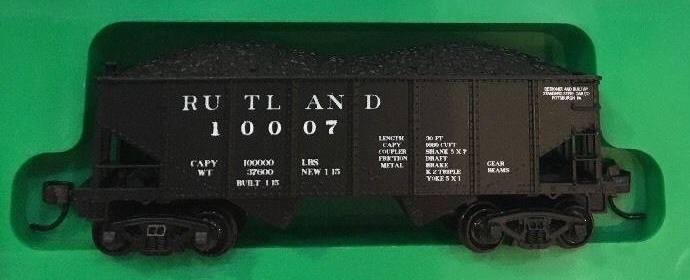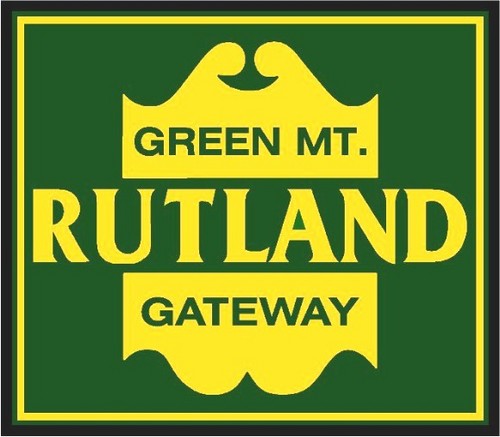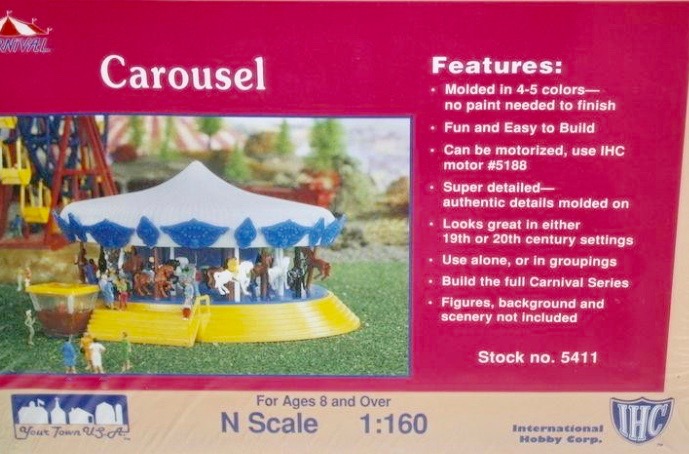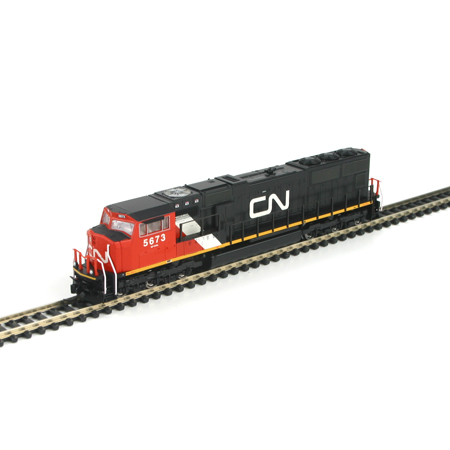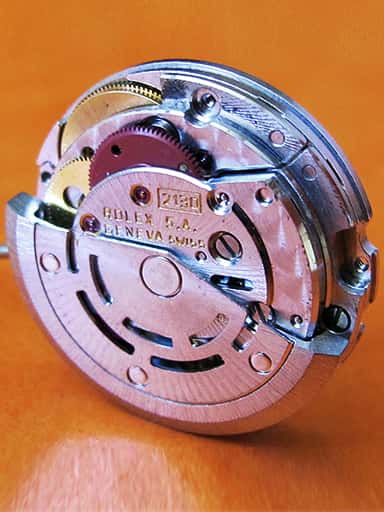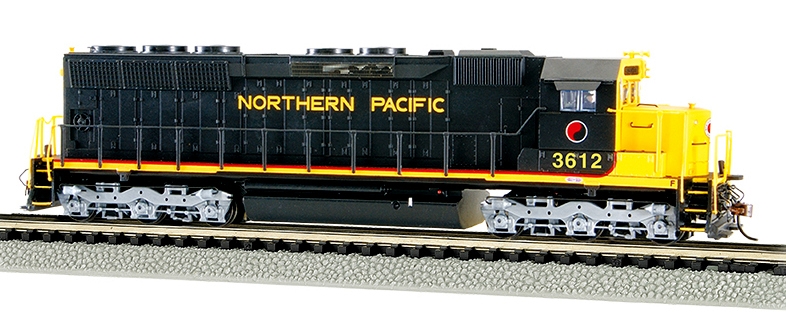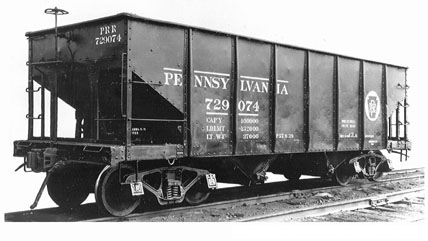Model Information: Bowser originally produced these models in kit form. However, all releases since 2007 or so are in Ready-To-Run (RTR) form. The kit form it included: a one piece plastic molded body, underframe, brake wheel, air reservoir, brake cylinder, control valve, X2f and McHenry KS couplers, plastic trucks/wheels and steel car weights.
This model comes in two variations: a vertical and a horizontal brake wheel. The ones with vertical brake wheels are delicate, so handle them with care. The plastic loads that come with the cars are low-to-mid grade quality and not up to the standards of the rest of this quite excellent car. Recent releases use high grade (MTL clone) body-mounted couplers and blackened metal wheels and are easily a nice value for their relatively low cost.
This model comes in two variations: a vertical and a horizontal brake wheel. The ones with vertical brake wheels are delicate, so handle them with care. The plastic loads that come with the cars are low-to-mid grade quality and not up to the standards of the rest of this quite excellent car. Recent releases use high grade (MTL clone) body-mounted couplers and blackened metal wheels and are easily a nice value for their relatively low cost.
Prototype History: In 1898, Pressed Steel Car Co. built the first all-steel hopper car designated the GL. The Pennsylvania Railroad would purchase several thousand of this design. Due to production backlogs at P.S.C.Co. and flaws in the initial design, the Penny came up with its own all-steel, bottom-discharge hopper car in 1904 designated the GLa. Approximately 30,000 GLa's were produced between 1904 and 1920. The Pennsy also built Gla's for numerous coal companies who were anxious for the well-built and reasonably priced cars. Until the 1960s, this design was one of the three most numerous classes of PRR freight cars. Although by this time, these cars began to rapidly disappear from the PRR roster, a few made it into the Penn Central and even Conrail rosters, lasting into the early 1980s.
Road Name History: The Rutland Railroad (reporting mark RUT) was a railroad in the northeastern United States, located primarily in the state of Vermont but extending into the state of New York at both its northern-most and southern-most ends. The earliest ancestor of the Rutland, the Rutland & Burlington Railroad, was chartered in 1843 by the state of Vermont to build between Rutland and Burlington. A number of other railroads were formed in the region, and by 1867 the Rutland & Burlington Railroad had changed its name to simply the Rutland Railroad.
Between 1871 and 1896 the Rutland Railroad was leased to the Central Vermont, regaining its independence when that road entered receivership. The New York Central Railroad briefly had a controlling interest in the Rutland from 1904, but sold half of its shares to the New York, New Haven & Hartford Railroad in 1911.
In 1901, the Rutland Railroad completed construction of a system of causeways and trestles across Lake Champlain, through the Champlain islands, to connect between Burlington, Vermont and Rouses Point, New York. The purpose of this construction was to give the Rutland access to Canada independent of the tracks of the competing Central Vermont. At the final approach to Rouses Point, though, both companies did end up sharing the same bridge over the Richelieu River by using an unusual gauntlet track that allowed sharing without the need for switches.[2] The causeway between Burlington and South Hero built at that time is today maintained as a recreation trail called The Island Line.[3] The company also had a line from Rutland, southeast to Bellows Falls, in southeastern Vermont, opposite New Hampshire, and a line from Rutland south to North Bennington, thence to Chatham, New York. Chatham was a major junction for connections via the New York Central to New York City and the Boston & Albany Railroad service to Massachusetts.
The Rutland's primary freight traffic was derived from dairy products and to many[by whom?] the railroad is fondly remembered for the long trains of milk that used to move over the system. At its peak the Rutland served about a 400-mile (600 km) system that roughly resembled an upside-down "L" running from Chatham, New York north to Alburgh, Vermont (the railroad's northernmost terminus was Noyan, Quebec) and thence west to Ogdensburg, New York along the St. Lawrence River. Never a solid financial operation, the Rutland entered receivership for the first time in 1938. Cost cutting, including wage reduction, brought things around. A reorganization in 1950 changed the name from Rutland Railroad to Rutland Railway.
In 1925, Rutland reported 259 million net ton-miles of revenue freight and 38 million passenger-miles on 413 miles of road and 559 miles of track; in 1960 it had 182 million ton-miles on 391 route-miles and 476 track-miles.
In 1961, after devastating strikes, the railroad apparently decided it was no longer viable and applied to the Interstate Commerce Commission for complete abandonment. This was approved, and the railroad closed down on May 20, 1963.
Much of the right-of-way was purchased by the State of Vermont. The Northern Division across the top of New York State from Ogdensburg to Norwood remains in tracks. Interestingly, it is operated by Vermont Railway, so all the remaining trackage of the Rutland is operated by one company. Ownership of the railbed from Norwood to Burlington has been dispersed, but a 21-mile (34 km) section from Norwood to Moira is the multi-use Rutland Trail.
Read more on Wikipedia.
Between 1871 and 1896 the Rutland Railroad was leased to the Central Vermont, regaining its independence when that road entered receivership. The New York Central Railroad briefly had a controlling interest in the Rutland from 1904, but sold half of its shares to the New York, New Haven & Hartford Railroad in 1911.
In 1901, the Rutland Railroad completed construction of a system of causeways and trestles across Lake Champlain, through the Champlain islands, to connect between Burlington, Vermont and Rouses Point, New York. The purpose of this construction was to give the Rutland access to Canada independent of the tracks of the competing Central Vermont. At the final approach to Rouses Point, though, both companies did end up sharing the same bridge over the Richelieu River by using an unusual gauntlet track that allowed sharing without the need for switches.[2] The causeway between Burlington and South Hero built at that time is today maintained as a recreation trail called The Island Line.[3] The company also had a line from Rutland, southeast to Bellows Falls, in southeastern Vermont, opposite New Hampshire, and a line from Rutland south to North Bennington, thence to Chatham, New York. Chatham was a major junction for connections via the New York Central to New York City and the Boston & Albany Railroad service to Massachusetts.
The Rutland's primary freight traffic was derived from dairy products and to many[by whom?] the railroad is fondly remembered for the long trains of milk that used to move over the system. At its peak the Rutland served about a 400-mile (600 km) system that roughly resembled an upside-down "L" running from Chatham, New York north to Alburgh, Vermont (the railroad's northernmost terminus was Noyan, Quebec) and thence west to Ogdensburg, New York along the St. Lawrence River. Never a solid financial operation, the Rutland entered receivership for the first time in 1938. Cost cutting, including wage reduction, brought things around. A reorganization in 1950 changed the name from Rutland Railroad to Rutland Railway.
In 1925, Rutland reported 259 million net ton-miles of revenue freight and 38 million passenger-miles on 413 miles of road and 559 miles of track; in 1960 it had 182 million ton-miles on 391 route-miles and 476 track-miles.
In 1961, after devastating strikes, the railroad apparently decided it was no longer viable and applied to the Interstate Commerce Commission for complete abandonment. This was approved, and the railroad closed down on May 20, 1963.
Much of the right-of-way was purchased by the State of Vermont. The Northern Division across the top of New York State from Ogdensburg to Norwood remains in tracks. Interestingly, it is operated by Vermont Railway, so all the remaining trackage of the Rutland is operated by one company. Ownership of the railbed from Norwood to Burlington has been dispersed, but a 21-mile (34 km) section from Norwood to Moira is the multi-use Rutland Trail.
Read more on Wikipedia.
Brand/Importer Information: On May 1, 1961, Bowser was purchased by Lewis and Shirlee English and moved from Redlands, CA to their basement in Muncy, PA. The original Bowser Manufacturing Co first advertised in the model railroad magazines in November 1948. At that time, the company had only one (HO Scale) engine, the Mountain, which had a cast brass boiler that is no longer available. It was sometime later that Bowser (Redlands) developed the NYC K-11 and the UP Challenger. The molds were made by K. Wenzlaff who introduced himself at the MRIA Show in Pasadena, CA in 1985 These two locomotives are still current production.
Bowser entered into N Scale in 1998 with their acquisition of the Delaware Valley Car Company, a manufacturer of N scale freight cars.
Bowser entered into N Scale in 1998 with their acquisition of the Delaware Valley Car Company, a manufacturer of N scale freight cars.
Item created by: gdm on 2016-07-14 15:59:13. Last edited by Alain LM on 2020-09-20 10:16:34
If you see errors or missing data in this entry, please feel free to log in and edit it. Anyone with a Gmail account can log in instantly.
If you see errors or missing data in this entry, please feel free to log in and edit it. Anyone with a Gmail account can log in instantly.


